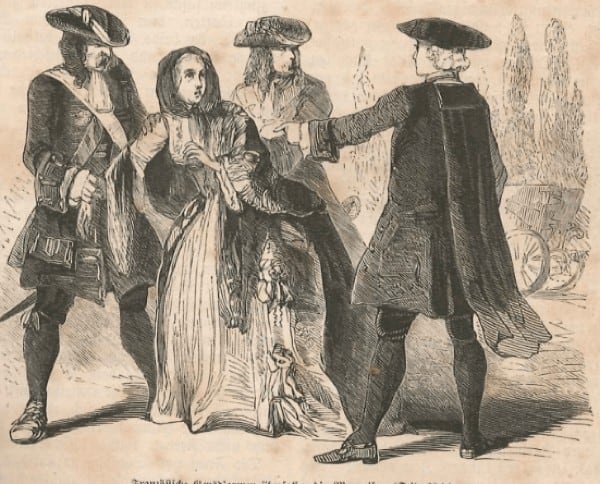On the 16 July 1676, a French noblewoman was ignominiously executed in front of a vast Parisian crowd. Transported to the scaffold in a dung cart, Marie-Madeleine Marguerite d’Aubray, the Marquise de Brinvilliers had been found guilty of murdering her father and two brothers by poison. She had also confessed to the attempted murder of her husband and her daughter. Lust, greed, and vengeance were the Marquise’s motivations. However, the way the authorities conducted her trial suggested something more than simple justice was behind her execution.
Fear of poison was rife in the aristocratic circles of seventeenth-century France. It was even rumored to be behind the death of Henrietta of England, King Louis XIV’s sister in law and the sister of Charles II. King Louis took a close interest in the Marquise’s case, negotiating her extradition from England after she fled arrest. Her execution proved to be just a prelude. For two years after the marquise’s death, the Affair of the Poisons began. Over a period of five years, the King executed thirty-six prominent French aristocrats on charges of poison and witchcraft. So what was the link between the life and crimes of the Marquise and these broader charges?

Madame de Brinvilliers and Godin de Sainte-Croix
Marie- Madeleine -Marguerite D’Aubray was born around 1630, the eldest child of Antoine Dreux d’Aubray, the Civil Lieutenant in charge of law and order in Paris. The d’Aubrays had a long history of service to the crown. Antoine D’Aubray’s father had been treasurer of France. The family was aristocratic, wealthy, and respectable. Through the ties of marriage and kinship, they were related to some of the most important families in France.
In 1651, Marie-Madeleine married Antoine Gobelin de Brinvilliers, the Marquise de Brinvilliers. The match was an auspicious one. The young Marquis had an income of 30,000 livres a year, on top of a lump sum he had received from his father five years previously. As for Marie-Madeleine, she came with a dowry of 150,000 livres and a personal fortune of 50, 000 livres. The new Marquise was young and acknowledged to be pretty, charming and intelligent. However, things swiftly began to go wrong. For the couple’s fortune rapidly began to disappear through gambling and extravagance.
In 1659, the Marquis introduced his wife to one of his gambling friends. Godin de Sainte-Croix, also known as the Chevalier de Sainte Croix. Sainte Croix had no notable pedigree. In fact, all he had to his name were debts and a bad reputation. However, he was handsome and talented, and Marie-Madeleine fell for him. The pair became lovers. This affair did not bother the Marquis de Brinvillier as it left him free to pursue his own. When he fled France to avoid his debtors, he left Marie-Madeleine behind to carry on an unchecked affair with Sainte-Croix.

The scandal of Marie Madeleine may not have bothered her husband. However, it reflected poorly on the position of her father. So, in her husband’s absence, Antoine D’Aubray applied to the king for an order of arrest or “letter de cachet” against Sainte- Croix. The King complied quickly because of D’Aubray’s position and in May 1663, Sainte Croix was arrested and imprisoned in the Bastille.
While he was in prison, Sainte-Croix made the acquaintance of another prisoner, an infamous Italian poisoner named Exili. Exili was a known assassin in the pay of Queen Christina of Sweden, and he was being kept under lock and key while the authorities investigated his reason for being in France. Sainte Croix became his cellmate and so to pass the time, Exili began to instruct the young officer in the art of poisoning. These lessons were paid for by the Marquise de Brinvillier who kept her lover well supplied with cash. When he was eventually released, Sainte Croix and Marie Madeleine began to put his new knowledge to ‘good’ use.

